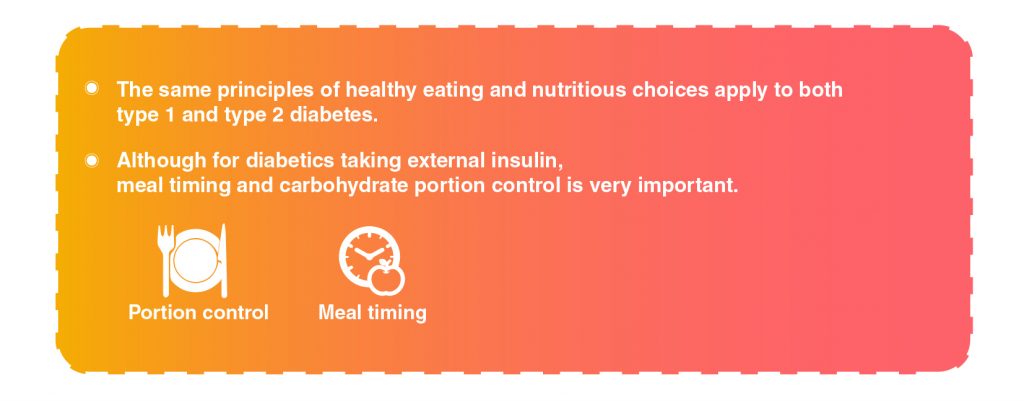Diabetic Food Chart
Overview
Diabetes mellitus, commonly known as diabetes is a chronic disease that occurs when blood glucose, also called blood sugar, is higher than usual. Blood glucose is the main source of energy for the body and comes from the food we eat. Over the long-term high glucose levels are associated with damage to the body and failure of various organs and tissues.

Since blood sugar levels are directly impacted by the intake of foods, nutrition is an essential part of managing diabetes. A healthy diet may also help manage weight, reduce the risk of cardiovascular disease, and help to live a longer and healthier life.
Types of Diabetes

Type 1
It occurs when the body fails to produce insulin. Patients with Type 1 diabetes will need to take insulin injections for the rest of their life.
Type 2
In this type of diabetes, the cells in the body do not react to insulin (this is also known as insulin resistance) or the insulin produced by the pancreas does not match the requirement of the body (insulin production is less).
It can be controlled with
- Healthy lifestyle (exercise and healthy food)
- Medication
- In some cases, external insulin may be required
Gestational Diabetes
A type of diabetes that consists of high blood glucose during pregnancy and is associated with complications to both mother and child. It can be controlled with exercise and medications.
Prediabetes
It is a condition where blood glucose levels are higher than normal, but not high enough to merit a diabetes diagnosis.
What are the differences in the diet of Type 1 and Type 2 diabetes?
The same principles of healthy eating and nutritious choices apply to both type 1 and type 2 diabetes and there are no major differences in dietary needs.
Although for diabetics taking external insulin, meal timing and carbohydrate portion control is very important

Portion control is a crucial element of any successful diabetic diet and helps to manage calorie intake and overall balance. The use of measuring cups and food scales may help to get more familiar with serving sizes for different foods. The key is to eat more frequently and in small portions.
Meal timing is very crucial for type 1 diabetics and those taking insulin. It is also important to spread carbohydrate intake throughout the day. Well planned meals may also help to keep blood sugar controlled and body energized throughout the day.
What is a recommended diet plan for diabetes?
Recommended Foods for a diabetic person include:

- Lean Proteins: Protein is an essential nutrient that plays a key role in maintaining the body’s cells, including muscle mass and is associated with reduced appetite and better weight management.
- Low-fat dairy: Low-fat dairy is also a source of important nutrients like calcium, vitamin D, and potassium and is associated with reduced risk of type 2 diabetes.
- Healthy Fats: Healthy fats may support heart health, assist in weight management, improve blood cholesterol, and help lower blood pressure. The best types of fats for diabetes are unsaturated fats like omega-3, monounsaturated and polyunsaturated fats.
- Non-starchy vegetables: Non-starchy vegetables contain little carbohydrates and tend to be very low in calories.
- Starchy vegetables: Starchy vegetables can contain more carbohydrates, but still tend to offer meaningful health benefits and nutrition.
- Fruits: Fruits should be included in a well-managed diabetes diet.
- Whole grains, Beans, and Lentils: Whole grain and complex carbohydrates help to get more fiber and nutrition.
Which foods should be avoided with diabetes?
A diabetic person should avoid:
- Added Sugars: Added sugars are a source of simple carbohydrates that are quickly absorbed into the bloodstream and have been linked to weight gain, diabetes, and many other chronic diseases. Common examples of added sugars include:
- Sugar
- Pasta
- White bread
- Refined Flour
- Cookies
- Pastries
- White potatoes
- Corn syrup
- Brown sugar
- Refined carbohydrates: Common processed foods that tend to be high in refined carbohydrates include:
- Soda
- Candy
- Cakes
- Cookies
- Packaged Baked Goods
- Ice Cream
- Dairy-Based Desserts
- Saturated and Trans fats: Saturated and trans fats have been linked to increased blood cholesterol and risk of heart disease. Common sources are:
- Full Fat Milk
- Cheese
- Cream
- Meat
- Butter
- Other Full Fat Dairy
- High Fat Processed Foods
- Processed Red Meats: Processed red meat such as bacon, sausage, corned beef has been associated with an increased risk of cancer, heart disease, and diabetes.
- High Sodium Foods: High sodium intake leads to poor heart health especially in those with type 2 diabetes. To decrease sodium, limit the amount of salt and be mindful of the portion size in below diet:
- Pizza
- Tomato Sauce
- Frozen Meals
- Processed Meat and Cheese
- Salty Snacks
- Pickles
- Cottage Cheese
- Bread
ABOUT US
Fit & Healthy Generation Kenya .
Reducing Non Communicable Disease burden through provision of equitable, diversified , all inclusive wellness & health programs
ALL CONTACTS
- Kibra Drive - Off Ngong Rd
- +254 706 674 766
- info@fhgkenya.org
- Open 8 am - 5 pm Sunday closed
SUBSCRIBE
Sign up today for news updates


Leave a Reply